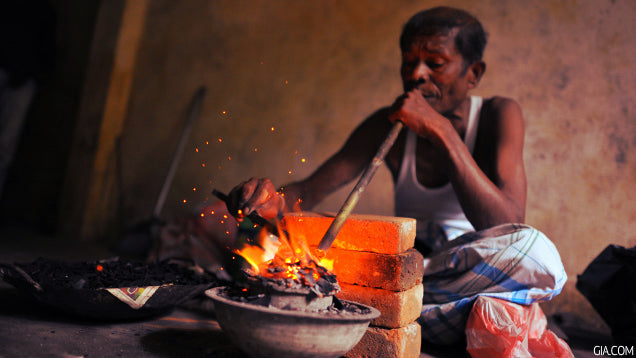Of Flame and Crystal January 23 2016
Gemologists around the world have carefully developed an assortment of techniques to enhance the color and clarity of natural sapphires. Some have been used for millennia whilst others have been introduced within the last few decades. It is commonplace for a sapphire gemstone to have received an enhancing treatment in order for it to catch the discerning eye of traders and consumers alike. This blog will feature four such treatments and capture some of the controversies involved in the newer techniques.

One of the most common and oldest techniques to treat a sapphire is through heat. The process involves a brief encounter of the sapphire in a blazing hot furnace reaching temperatures ranging from 4,000 degrees Celsius to 17,000 degrees Celsius. The heat helps to dissolve the rutile imperfections within the crystal structure amongst other changes and improves the overall saturation of the gemstone. Although heat treated sapphires account for the vast majority of sapphire sales, a very strong niche exists for the allure of stunning untreated sapphires as a result of its extreme rarity.
A recent technique involves a chemical flux treatment. It is often minute fractures and cavities within the corundum crystal that gives rise to an impairment in clarity and durability. In order to mend this, a sapphire can be heated once again but with the presence of a chemical flux that will melt and fill these gaps. Once cooled, it may solidify into a transparent structure within the crystal (fracture filling) or promote re-crystallization within the cavities (flux healing). This treatment rarely exists within the sapphire industry but has been widely reported throughout the ruby trade. Controversies involved in this treatment complain that the flux basically holds together poor quality gemstones through a transparent paste and makes it increasingly brittle to be able to not even withstand routine jewelry cleaning and polishing.
The most controversial treatment involves diffusion with agents such as Beryllium and Titanium. In this technique, the sapphire is heated close to its melting point and then introduced to these coloring agents. The alien element diffuses uniformly around the crystal and creates an illusion of excellent saturation and tone. The issue is that this coloring agent creates only a layer within the gemstone and the true nature can be revealed once polished or unfortunately (or fortunately in this case) chipped. Beryllium helps to color a sapphire in a lush orange whilst Titanium generates a deep blue hue. The relative color changes can be easily detected by a trained jeweler and is often heavily discounted due to the façade it pulls to mask a sub-par sapphire.
Although rare in occurrence, sapphires can also be subject to carefully controlled irradiation to generate brighter yellows and darker oranges. Once again, a trained jeweler has an array of tests to identify this treatment. The issue is that the color often fades upon exposure to bright light or high temperatures. Therefore, this treatment is often temporary and can be easily detected using a brief encounter with a strong showcase lamp.
The processes of heat, chemical flux, diffusion and irradiation have been used to treat sapphires in a wide array of circumstances. However, it is often the time tested technique that continues to prevail within the industry. As a result, the heat treatment of sapphires is the widely accepted technique used to enhance the sapphire’s allure to the consumer.
